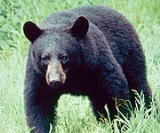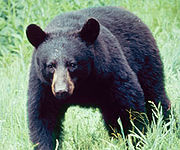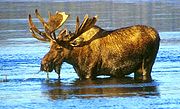
Fauna of Maine
Encyclopedia
The fauna of Maine include several diverse land and aquatic animal species, especially those common to the North Atlantic Ocean and deciduous forests of North America
. Some of these creatures' habitats has been reduced or fully removed.

, woodland jumping mouse
, meadow vole
, Southern red-backed vole
, rock vole
, woodland vole
, Southern bog lemming
, Northern bog lemming
, hairy-tailed mole
, star-nosed mole
, water shrew
, smoky shrew
, long-tailed shrew
, pygmy shrew
, cinereus shrew, and the Northern short-tailed shrew
.
(Known as Pine marten in some areas of New England even though the Pine marten is a separate species.).

 The mammals not included in the text above are the white-tailed deer, moose, red squirrel, Eastern gray squirrel, Eastern chipmunk, woodchuck, Northern racoon, Virginia opossum, striped skunk, North American porcupine, common muskrat, eastern cottontail, New England Cottontail, and the American Beaver.
The mammals not included in the text above are the white-tailed deer, moose, red squirrel, Eastern gray squirrel, Eastern chipmunk, woodchuck, Northern racoon, Virginia opossum, striped skunk, North American porcupine, common muskrat, eastern cottontail, New England Cottontail, and the American Beaver.
, peregrine falcon
, great horned owl
, barn owl
, barred owl
, long-eared owl
, Great Gray Owl, Northern saw-whet owl
, common nighthawk
, whip-poor-will
, chimney swift
, common loon, pied-billed grebe
, horned grebe, red-necked grebe
, Northern fulmar
, Greater Shearwater, sooty shearwater
, manx shearwater
, Wilson's storm-petrel
, Leach's storm-petrel
, piping plover
, American pipit, Arctic tern
, Atlantic puffin
, black tern
, Harlequin duck
, razorbill
, black-capped chickadee
, indigo bunting
, scarlet tanager
, mallard
, wood duck
, American black duck
, Canada goose
, American goldfinch
, tufted titmouse
, mourning dove
, Northern goshawk, golden eagle
, sharp-shinned hawk
, cooper's hawk
, northern harrier, and red-tailed hawk
.
 Some species that have been extirpated from Maine are the cougar, caribou, and grey wolf.
Some species that have been extirpated from Maine are the cougar, caribou, and grey wolf.
North America
North America is a continent wholly within the Northern Hemisphere and almost wholly within the Western Hemisphere. It is also considered a northern subcontinent of the Americas...
. Some of these creatures' habitats has been reduced or fully removed.
Large Carnivores
These include the red and gray foxes, coyote, bobcat, Canadian lynx, and the black bear.
Bats
The bats of Maine include the following: Eastern pipistrelle, big brown bat, little brown myotis, Eastern small-footed myotis, Northern myotis, Eastern red bat, hoary bat, and the silver-haired bat.Vermin
The vermin of Maine include the following: North American deermouse, white-footed deermouse, meadow jumping mouseMeadow jumping mouse
The meadow jumping mouse is the most widely distributed mouse in the subfamily Zapodinae. It may be found from the Atlantic coast, to the Great Plains, as far north as the arctic tree lines in Canada and Alaska, and as far south as Georgia, Alabama, Arizona, and New Mexico.- Description :The...
, woodland jumping mouse
Woodland jumping mouse
The Woodland jumping mouse is a species of jumping mouse found in North America. It can hop surprisingly long distances given its small size. The mouse is an extraordinary part of the rodent family. Its scientific name in Latin is Napaeozapus insignis, meaning glen or wooded dell + big or strong...
, meadow vole
Meadow Vole
The Meadow Vole , sometimes called the Field Mouse or Meadow Mouse, is a North American vole found across Canada, Alaska and the northern United States. Its range extends further south along the Atlantic coast. One subspecies, the Florida Salt Marsh Vole , is found in Florida, and is classified as...
, Southern red-backed vole
Southern Red-backed Vole
The Southern Red-backed Vole or Gapper's Red-backed Vole is a small slender vole found in Canada and the northern United States...
, rock vole
Rock Vole
The Rock Vole is a medium-sized vole found in eastern North America. It is also called the Yellow-nosed Vole....
, woodland vole
Woodland Vole
The Woodland Vole, Microtus pinetorum, is a small vole found in eastern North America. It is also known as the Pine Vole.-Description:...
, Southern bog lemming
Southern Bog Lemming
The Southern Bog Lemming, Synaptomys cooperi is a small North American lemming. Its range overlaps with the other species in genus Synaptomys, the Northern Bog Lemming, in southeastern Canada but extends further south....
, Northern bog lemming
Northern Bog Lemming
The Northern Bog Lemming, Synaptomys borealis is a small North American lemming. This is one of two species in genus Synaptomys, the other being the Southern Bog Lemming....
, hairy-tailed mole
Hairy-tailed Mole
The Hairy-tailed Mole , also known as Brewer's Mole, is a medium-sized North American mole. It is the only member of the genus Parascalops....
, star-nosed mole
Star-nosed mole
The star-nosed mole is a small mole found in wet low areas of eastern Canada and the north-eastern United States, with records extending along the Atlantic coast as far as extreme southeastern Georgia...
, water shrew
Water Shrew
Water Shrew may refer to any of several species of semi-aquatic red-toothed shrews:*Asiatic water shrews **Malayan Water Shrew **Himalayan Water Shrew **Sunda Water Shrew...
, smoky shrew
Smoky Shrew
The Smoky Shrew, Sorex fumeus, is a medium-sized North American shrew found in eastern Canada and the northeastern United States.It is dull grey in colour with lighter underparts and a long tail which is brown on top and yellowish underneath. During winter, its fur is grey...
, long-tailed shrew
Long-tailed Shrew
The Long-tailed Shrew or Rock Shrew is a small North American shrew found in Atlantic Canada and the north-eastern United States....
, pygmy shrew
Pygmy Shrew
The American Pygmy Shrew is a small shrew found in Alaska, Canada and the northern United States down through the Appalachian Mountains. It was first discovered in 1831 by the acclaimed naturalist William Cane in Georgian Bay, Parry Sound....
, cinereus shrew, and the Northern short-tailed shrew
Northern Short-tailed Shrew
The Northern Short-tailed Shrew is the largest shrew in the genus Blarina, and occurs in the northeastern region of North America. It is a semifossorial, highly active and voracious insectivore and is present in a variety of habitats. It is notable in that it is one of the few venomous mammals...
.
Weasels
The various species of weasels include: Northern river otter, American mink, long-tailed weasel, Ermine or short-tailed weasel, fisher (in New England is known as a fisher cat), and the American martenAmerican Marten
The American marten is a North American member of the family Mustelidae, sometimes referred to as the pine marten. The name "pine marten" is derived from the common but distinct Eurasian species of Martes...
(Known as Pine marten in some areas of New England even though the Pine marten is a separate species.).
Other Mammals


Birds
Of the many birds in Maine, a small fraction of them are the bald eagleBald Eagle
The Bald Eagle is a bird of prey found in North America. It is the national bird and symbol of the United States of America. This sea eagle has two known sub-species and forms a species pair with the White-tailed Eagle...
, peregrine falcon
Peregrine Falcon
The Peregrine Falcon , also known as the Peregrine, and historically as the Duck Hawk in North America, is a widespread bird of prey in the family Falconidae. A large, crow-sized falcon, it has a blue-gray back, barred white underparts, and a black head and "moustache"...
, great horned owl
Great Horned Owl
The Great Horned Owl, , also known as the Tiger Owl, is a large owl native to the Americas. It is an adaptable bird with a vast range and is the most widely distributed true owl in the Americas.-Description:...
, barn owl
Barn Owl
The Barn Owl is the most widely distributed species of owl, and one of the most widespread of all birds. It is also referred to as Common Barn Owl, to distinguish it from other species in the barn-owl family Tytonidae. These form one of two main lineages of living owls, the other being the typical...
, barred owl
Barred Owl
The Barred Owl is a large typical owl. It goes by many other names, including eight hooter, rain owl, wood owl, and striped owl, but is probably best known as the hoot owl.-Description:...
, long-eared owl
Long-eared Owl
The Long-eared Owl - Asio otus is a species of owl which breeds in Europe, Asia, and North America. This species is a part of the larger grouping of owls known as typical owls, family Strigidae, which contains most species of owl...
, Great Gray Owl, Northern saw-whet owl
Northern Saw-whet Owl
The Northern Saw-whet Owl is a small owl native to North America.-Description:The scientific description of one of the sub-species of this owl is attributed to the Rev. John Henry Keen who was a missionary in Canada in 1896. Adults are long with a wingspan. They can weigh from with an average...
, common nighthawk
Common Nighthawk
The Common Nighthawk is a medium-sized crepuscular or nocturnal bird, whose presence and identity are best revealed by its vocalization. Typically dark , displaying cryptic colouration and intricate patterns, this bird becomes invisible by day. Once aerial, with its buoyant but erratic flight,...
, whip-poor-will
Whip-poor-will
The Eastern Whip-poor-will, Caprimulgus vociferus, is a medium-sized nightjar from North and Central America. The whip-poor-will is commonly heard within its range, but less often seen because of its superior camouflage...
, chimney swift
Chimney Swift
The Chimney Swift is a small bird .-Physical description:In flight, this bird looks like a flying cigar with long slender curved wings. The plumage is a sooty grey-brown; the throat, breast, underwings and rump are paler. They have short tails.-Reproduction:The breeding season of Chimney Swifts is...
, common loon, pied-billed grebe
Pied-billed Grebe
The Pied-billed Grebe is a species of the grebe family of water birds. Since the Atitlán Grebe, Podilymbus gigas, has become extinct, it is the sole extant member of the genus Podilymbus.-Description:...
, horned grebe, red-necked grebe
Red-necked Grebe
The Red-necked Grebe is a migratory aquatic bird found in the temperate regions of the northern hemisphere. Its wintering habitat is largely restricted to calm waters just beyond the waves around ocean coasts, although some birds may winter on large lakes...
, Northern fulmar
Northern Fulmar
The Northern Fulmar, Fulmarus glacialis, Fulmar, or Arctic Fulmar is a highly abundant sea bird found primarily in subarctic regions of the north Atlantic and north Pacific oceans. Fulmars come in one of two color morphs: a light one which is almost entirely white, and a dark one which is...
, Greater Shearwater, sooty shearwater
Sooty Shearwater
The Sooty Shearwater is a medium-large shearwater in the seabird family Procellariidae. In New Zealand it is also known by its Māori name tītī and as "muttonbird", like its relatives the Wedge-tailed Shearwater and the Australian Short-tailed Shearwater The Sooty Shearwater (Puffinus griseus) is...
, manx shearwater
Manx Shearwater
The Manx Shearwater is a medium-sized shearwater in the seabird family Procellariidae. The scientific name of this species records a name shift: Manx Shearwaters were called Manks Puffins in the 17th century. Puffin is an Anglo-Norman word for the cured carcasses of nestling shearwaters...
, Wilson's storm-petrel
Wilson's Storm-petrel
Wilson's Storm Petrel , also known as Wilson's Petrel, is a small seabird of the storm-petrel family. It is one of the most abundant bird species in the world and has a circumpolar distribution mainly in the seas of the southern hemisphere but extending northwards during the summer of the northern...
, Leach's storm-petrel
Leach's Storm-petrel
The Leach's Storm Petrel or Leach's Petrel is a small seabird of the tubenose family. It is named after the British zoologist William Elford Leach....
, piping plover
Piping Plover
The Piping Plover is a small sand-colored, sparrow-sized shorebird that nests and feeds along coastal sand and gravel beaches in North America. The adult has yellow-orange legs, a black band across the forehead from eye to eye, and a black ring around the neck...
, American pipit, Arctic tern
Arctic Tern
The Arctic Tern is a seabird of the tern family Sternidae. This bird has a circumpolar breeding distribution covering the Arctic and sub-Arctic regions of Europe, Asia, and North America...
, Atlantic puffin
Atlantic Puffin
The Atlantic Puffin is a seabird species in the auk family. It is a pelagic bird that feeds primarily by diving for fish, but also eats other sea creatures, such as squid and crustaceans. Its most obvious characteristic during the breeding season is its brightly coloured bill...
, black tern
Black Tern
The Black Tern, Chlidonias niger, is a small tern generally found in or near inland water in Europe and North America. As its name suggests, it has predominantly dark plumage.- Description :...
, Harlequin duck
Harlequin Duck
The Harlequin Duck is a small sea duck. It takes its name from Arlecchino, Harlequin in French, a colourfully dressed character in Commedia dell'arte. The species name comes from the Latin word "histrio", "actor". In North America it is also known as Lords and ladies...
, razorbill
Razorbill
The Razorbill is colonial seabird that will only come to land in order to breed. It is the largest living member of the Auk family. This agile bird will choose only one partner for life and females will lay one egg per year. Razorbills will nest along coastal cliffs in enclosed or slightly exposed...
, black-capped chickadee
Black-capped Chickadee
The Black-capped Chickadee is a small, North American songbird, a passerine bird in the tit family Paridae. It is the state bird of both Maine and Massachusetts in the United States, and the provincial bird of New Brunswick in Canada...
, indigo bunting
Indigo Bunting
The Indigo Bunting, Passerina cyanea, is a small seed-eating bird in the family Cardinalidae. It is migratory, ranging from southern Canada to northern Florida during the breeding season, and from southern Florida to northern South America during the winter. It often migrates by night, using the...
, scarlet tanager
Scarlet Tanager
The Scarlet Tanager is a medium-sized American songbird. Formerly placed in the tanager family , it and other members of its genus are now classified in the cardinal family . The species's plumage and vocalizations are similar to other members of the cardinal family.-Description:Adults have pale...
, mallard
Mallard
The Mallard , or Wild Duck , is a dabbling duck which breeds throughout the temperate and subtropical Americas, Europe, Asia, and North Africa, and has been introduced to New Zealand and Australia....
, wood duck
Wood Duck
The Wood Duck or Carolina Duck is a species of duck found in North America. It is one of the most colourful of North American waterfowl.-Description:...
, American black duck
American Black Duck
The American Black Duck is a large dabbling duck. American Black Ducks are similar to Mallards in size, and resemble the female Mallard in coloration, although the Black Duck's plumage is darker...
, Canada goose
Canada Goose
The Canada Goose is a wild goose belonging to the genus Branta, which is native to arctic and temperate regions of North America, having a black head and neck, white patches on the face, and a brownish-gray body....
, American goldfinch
American Goldfinch
The American Goldfinch , also known as the Eastern Goldfinch and Wild Canary, is a small North American bird in the finch family...
, tufted titmouse
Tufted Titmouse
The Tufted Titmouse, Baeolophus bicolor, is a small songbird from North America, a species in the tit and chickadee family . The Black-crested Titmouse, found from central and southern Texas southwards, was included as a subspecies but is now considered a separate species B...
, mourning dove
Mourning Dove
The Mourning Dove is a member of the dove family . The bird is also called the Turtle Dove or the American Mourning Dove or Rain Dove, and formerly was known as the Carolina Pigeon or Carolina Turtledove. It is one of the most abundant and widespread of all North American birds...
, Northern goshawk, golden eagle
Golden Eagle
The Golden Eagle is one of the best known birds of prey in the Northern Hemisphere. Like all eagles, it belongs to the family Accipitridae. Once widespread across the Holarctic, it has disappeared from many of the more heavily populated areas...
, sharp-shinned hawk
Sharp-shinned Hawk
The Sharp-shinned Hawk is a small hawk. In fact, "sharp-shins" or "sharpies" are the smallest to reside in USA and Canada, though some Neotropical species are smaller...
, cooper's hawk
Cooper's Hawk
Cooper's Hawk is a medium-sized hawk native to the North American continent and found from Canada to Mexico. As in many birds of prey, the male is smaller than the female...
, northern harrier, and red-tailed hawk
Red-tailed Hawk
The Red-tailed Hawk is a bird of prey, one of three species colloquially known in the United States as the "chickenhawk," though it rarely preys on standard sized chickens. It breeds throughout most of North America, from western Alaska and northern Canada to as far south as Panama and the West...
.
Extirpated


